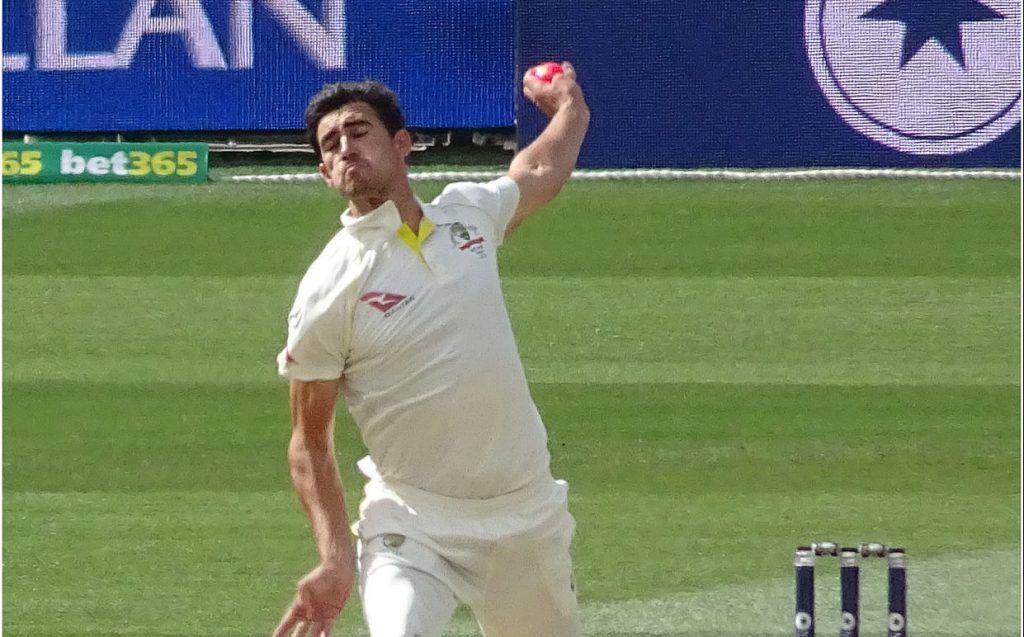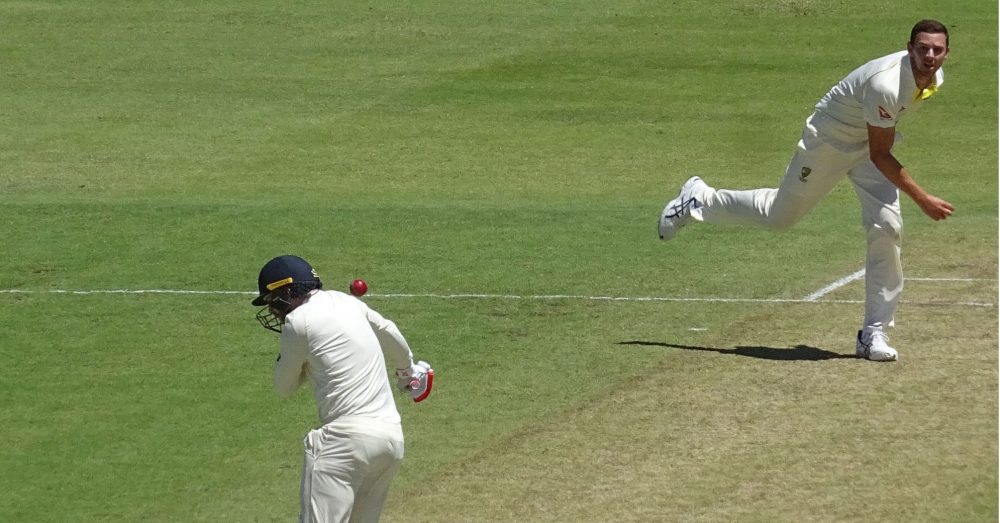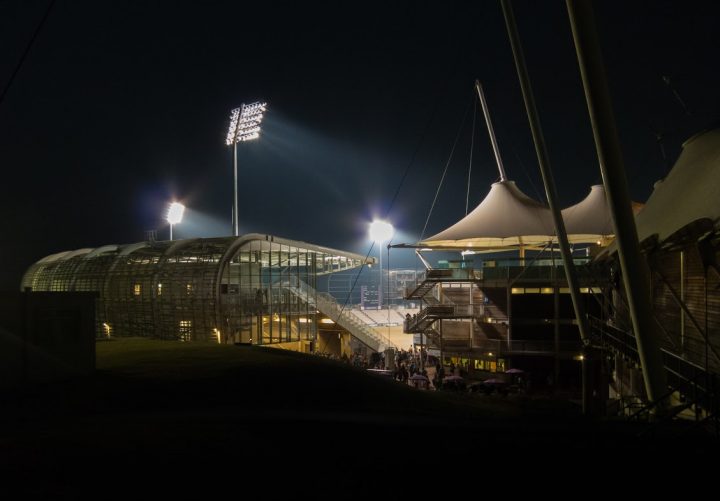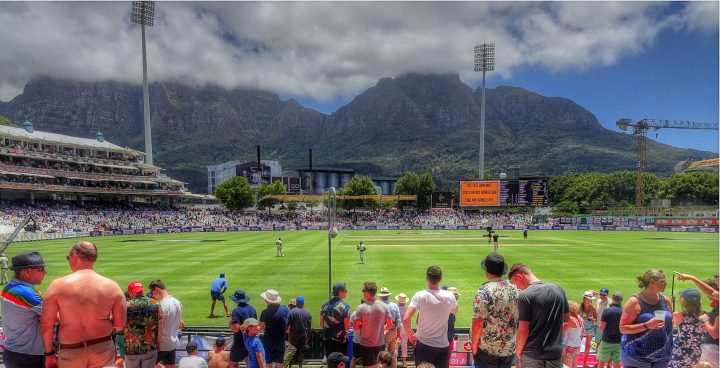The standard cricket ball weighs around 5½ ounces; it can be no more than 9 inches in circumference, with a diameter of no more than 2.86 inches. Its core is made of cork which is layered with tightly wound string and covered by a leather case with a stitched seam. The ball is then coated with red or white paint for use in long and short forms of the game. Roughly the size of a tennis ball, it is solid with sharp ridges created by the seam. In the hands of a pace bowler it can be a weapon of destruction as batsmen try to defend themselves and score runs off the delivery.
The ten fastest bowlers in history have enjoyed mixed fortunes at test level. A curious mix of injury, loss of form and ill-discipline do no justice to the explosive power that sometimes burned too briefly. Top of the all-time list is Shoaib Akhtar of Pakistan, who was timed at 100.2 mph during the World Cup in 2003. Many sobriquets were bestowed including the Rawalpindi Express and Tiger; the more imaginative headline writers came up with Nuclear Re-Akhtar. While Akhtar’s test record is good it belies a reputation that promised so much more. He played in 46 test matches spread over 10 years, and took 178 wickets at an average of 25.69. One would expect double the number of tests and wickets over the same period.
However, Akhtar was plagued by injuries and a poor temperament that regularly landed him in trouble. The first blow-up in 2003 resulted in a ban for ball tampering, and the following year he was sanctioned for abusing Paul Adams of South Africa. The hits just kept on coming as Akhtar tested positive for nadrolone in 2006. Although a two year ban was eventually overturned his credentials as the bad boy of cricket had been established. More spats followed including many bust-ups with team mates and an undignified slanging match with the Pakistan Cricket Board which resulted in further bans.
Injuries played their part but it was Akhtar’s attitude that frequently caused his omission from the test side. Interestingly, his record in one day internationals outstripped his test career. He played in 163 ODIs and took 247 wickets at an average of 24.97; and that monster delivery arrived during the aforementioned World Cup match against England. The one day format would certainly appear kinder to pace bowlers and Akhtar was no exception. They will bowl no more than 10 overs in a one day game, but may be required to bowl in excess of 20 overs during one day of a test match.
Aussie Brett Lee also extended his international career in the short version of the game. He is just behind Akhtar in the all-time list after unleashing a delivery of 100.1 mph against New Zealand in 2005. Like any bowler Lee could never sustain that pace over long spells. However, he was consistently in the range of 71-81 mph, and the stress of bowling at this speed took its toll. He suffered a succession of injuries to his back, ankle and elbow. In 76 test matches he took 310 wickets at an average of 30.81. A much longer ODI career gave Lee healthier figures as he played in 221 ODIs, taking 380 wickets at an average of 23.36. Unlike Akhtar, he was nowhere near as controversial. The suspect temperament was obviously missing from his pace bowlers kit when it arrived. The closest he got was the report of an illegal bowling action and accusation of delivering the odd beamer – surely a rite of passage for all quicks?
Shaun Tait is one of five Australians featuring in the top 10 list of fastest bowlers. At 6ft 5in he was an intimidating sight for any batsman and the nickname Wild Thing was well earned. However, consistency would always be an issue as Tait struggled with his bowling action. He played in only 3 test matches spread over three years. He took 5 wickets at an average of 60.40 with best bowling figures of 3 for 97. The less demanding format of limited overs cricket again provided a useful outlet. Tait played in 35 ODIs taking 62 wickets at an average of 23.56. A delivery of 100.1 mph against England places him level with fellow countryman Brett Lee. Tait’s career was riddled with injury and his gradual retirement began when he stepped down from first class cricket in 2009. Retirement from ODIs followed two years later whilst a chronic elbow problem forced him to stop altogether in 2017.
It is perhaps surprising that Jeff Thomson didn’t finish higher than 4th in the list of fastest bowlers. Some of the greatest batsmen in history have testified to the ferocity of a Tommo delivery. Viv Richards, Sunil Gavaskar and Clive Lloyd all agree he was the fastest they had ever seen. Along with Dennis Lillee he was the scourge of England batsmen during the 1974-75 Ashes tour. He stoked the flames of fear during a TV interview ‘I enjoy hitting a batsman more than getting him out. I like to see blood on the pitch’. It may have been a carefully staged mind game but was that level of rancour really necessary? It obviously worked as Australia won the series 4-1 and Thomson took 33 wickets. Thomson’s fastest recorded delivery was 99.8 and his unique bowling action often made him unplayable. He had a patchy test career interrupted by injury and variable form; but made 50 test appearances and took 200 wickets with an average of 28.

When Mitchell Starc made his test debut in 2011 he was the latest in a long line of world class Australian pace bowlers; and has the rare distinction of playing for Australia regularly across all formats of the game. His fastest delivery placing him 5th in the table was timed at 99.7 against New Zealand. Starc is the only bowler in the top 10 still active in test cricket and has an enviable record. 61 test matches have bought 255 wickets at an average of 27.57. In the short versions of the game he has an average in the low 20s for both ODIs and T20.
It’s no real co-incidence that Andy Richards shared the same nickname as legendary middleweight boxer Thomas Hearns. ‘Hitman’ was an apt description for the Antiguan who was timed at 99.1 mph placing him 6th in the all-time table. Like Jeff Thomson, his true position might be obscured by the quality of equipment available to test his bowling speed. Roberts retired from cricket in 1984 and my own memory dictates he must have bowled faster than that. He emerged as a test bowler in the mid-70s and was at the forefront of a conveyor belt of West Indian bowling talent that included Michael Holding, Joel Garner and Colin Croft. A surprisingly short 47 test career yielded 202 wickets at an average of 25.61.
Fidel Edwards falls into that rather annoying category of ‘might have been’ with the annotation ‘unfulfilled potential’. He had the dual enemy of inconsistency and injury and both have peppered his career. Yet Edwards is still plugging away at 39 and won a recall to the West Indies T20 side in February. His 7th place was earned with a delivery of 97.9 mph in 2003 but regularly hovers in the 80s. In 55 test matches Edwards took 165 wickets with an average of 37.87, and is a faint reflection of his abilities, but demonstrates a familiar pattern in many bowlers of his ilk.
Mitchell Johnson is the reincarnation of Lillee and Thomson at their devastating best. Placed 8th in all-time list, his fastest recorded delivery of 97.4 mph was against England in 2013. The Queensland native has taken 313 wickets at an average of 28.40. Across 73 test appearances he was the spearhead of the Australian attack. The fact was made abundantly clear during the 2013 Ashes test in Brisbane. As Johnson prepared to bowl Aussie captain Michael Clarke hissed in Jimmy Anderson’s ear get ready for a broken arm. This was a long way from the playful sledging of Shane Warne (you gotta give back your MBEs now?!). And showed that pace bowlers are often used as a weapon of intimidation.
Mohammed Sami of Pakistan had a big reputation built by others; Imran Khan hailed him as the new Malcolm Marshall. Millions across the world gently stroked their chins as he flattered to deceive. In 36 test matches spread over 11 years Sami took 85 wickets at an average of 52.74. There have been many lows, including a 17 ball over against Bangladesh consisting of 7 wides and four no-balls. However, he is the only bowler in cricket history to take hat-tricks in all three formats of the game. Ninth spot in the all-time list was secured by a delivery 97.1 mph against Zimbabwe in 2003.
Completing the all-time top 10 fastest bowlers is Shane Bond of New Zealand. His career was disrupted by injuries, particularly a severe back injury which required the insertion of a titanium rod. Bond combined pace with control and accuracy: the Holy Grail for any pace bowler. An 18 match test career yielded 87 wickets at an average of 22.09. His fastest delivery was timed at 97.1 mph in a match against India in the 2003 World Cup.
Bowling speeds can only tell us so much and are at best a snapshot. More indicative are average speeds over a sustained spell of bowling. This might reduce dramatically for bowlers who unleash one cannonball if the conditions and format are right. (Interestingly the majority of fastest deliveries come during one day internationals). Then there are players whose careers pre-dated reliable testing equipment. Wes Hall and Charlie Griffith were prototype West Indian pace bowlers of the early 60s; while Frank ’Typhoon’ Tyson was a talent that flowered briefly for England in the mid-50s. Of course the big daddy of all fast bowlers Harold Larwood retired before the war, and one wonders whether the fastest bowlers in history have been properly measured.
The ability to bowl at such a murderous pace begs a number of questions. Do pace bowlers sacrifice accuracy and the promise of a wicket just to weaken a batsman’s resistance? There is a fascinating contrast between the top test wicket takers and 10 fastest bowlers. It might suggest the ‘quicks’ exist more to unsettle opponents who are later picked off by a slower bowler. Spin and mid pace bowlers are well represented in the upper echelons of the test chart; but pace bowlers often aren’t as frequent as might expect. Surprisingly, the highest placed member of the ‘ten fastest’ club is Mitchell Johnson in 29th place. We can make stats say many things but the facts are generally inescapable.
Brian Penn









Of course the accuracy of the measurement has improved considerably since the days of Tommo and the medley of West Insiand quicks.
…Indian quicks!
If you forget the technology for a moment and speak to the batsmen Boycott would tell you that Frank Tyson in Australia, I think for a brief spell in 1955, sustained speeds he thought were the fastest ever.
Larwood in the old Bodyline clips looks terrifyingly fast. More recently I thought Sylvester Clarke at Surrey was also up there with the quickest. And don’t forget Devon Malcolms spell against SA in 1994, a one off maybe but blimey I was thier and it was fast on a real humdinger Oval pitch.
The “Demon” Spoforth in the 1880s perhaps? We’ll never know!
No Michael Holding?? Don’t make me laugh!
I don’t think you mentioned the outcome of Shosib Akhtar’s 100.2mph delivery to Nick Knight – pushed to extra cover, no run.
Shoaib, or course.
I remember, years ago, Ossie Wheatley, the Glamorgan bowler, explaining how he got late swing. His theory was that when the ball was travelling faster than a given speed, it didn’t swing; as it dropped below this speed on its way to the other end, the swing would kick in. I’m not sure how correct this was!
The 100+ speed gun readings by Shoiab and Lee should be treated with considerable scepticism – they just happened to be great advertising for the 2003 WC. Indeed all of them are somewhat dubious in my book.
The writer in his comments on Shoaib and Andy Roberts doesn’t seem aware that some teams don’t play as much Test cricket as England. Roberts also missed about 18 months to Packer (those ‘supertests’ should be added to Test records imo – they were tougher than many Tests then and now). Roberts, like Hadlee and Wasim, throttled back under a heavy workload and bowling a lot in England where movement and accuracy tend to count for more.
It’s unfair imo to compare bowlers who were fast over a sustained period of time and those who were very quick very briefly but whose method couldn’t sustain it (Tait and NZ’s Adam Milne would be examples – so I fear might be Jofra Archer). There’s a myth that Thomo was only quick briefly and was never the same after a serious shoulder injury – but he was very quick afterwards (a spell in WI in 1977/78 was rated the fastest they ever saw by Viv Richards and Tony Cozier when Thomo was riled by the WI quicks peppering Bruce Yardley. Sadly, thee’s no film of it) and he played a major role in Australia winning back the Ashes in 1982/83. A combination of stodgy pitches and no-ball problems meant he was never that effective in England.
Colin Croft and Sylvester Clarke were two who had reputations as being extremely nasty to face – they combined high pace with a difficult in-slanting angle and the image that they genuinely didn’t like batsmen. Patrick Patterson and Wayne Daniel were also two mean dudes – and there’s the strange story of what happened to Patterson after he left cricket….
In 1975 I was at Edgbaston watching Warwickshire, including Amiss wearing a crash helmet for the first time, take on the touring Australians, including Lillee and Thompson. I was sitting sideways on to the action and had no trouble seeing the ball when Lillee was bowling but when Thompson bowled I could not. How Marsh managed behind the stumps was a mystery to me, as Thompson was not the most accurate of quicks. I have experienced this and I’ve seen every renowned quick since. Thommo used to wrestle wild pigs as a recreation to build his upper body strength. Nowadays bowlers spend time in the gym and seem to spend even more time injured. Maybe Thommo had the answer all the time.
Marc
That’s interesting. I had a similar experience. I always used to make a point of watching a quick I hadn’t seen before, from ground level in the Grandstand at Lord’s. I did so in 1975 and my experience was the same as your’s. For what it’s worth I found Holding and Hogg more difficult to pick up than I did Lille. You mention Marsh. An interesting piece of trivia is that he kept wicket to every ball Lillee bowled in Test cricket ! For all I know that may we’ll be true of several otherAustralian bowlers including Thomson.
I used to enjoy going to watch the players warming up in the net before a test match. The Windies quicks used to lope in off a few paces and the next thing you saw was the net bulging about 6 feet up. How batsmen acclimatise to this has always been a mystery to me as I always thought of myself as a half decent club opener in the leagues, but how I would have managed to stay out of hospital against this I don’t know.
I used to enjoy going and watching the players in the nets at the start of a day’s play, especially the Windies bowlers. They loped in off a couple of paces and the next thing you saw was the net bulge a foot or two above the stumps. The mind boggles that it’s possible to adjust to facing this. I always fancied myself a decent league opener but I would have ended up in hospital.